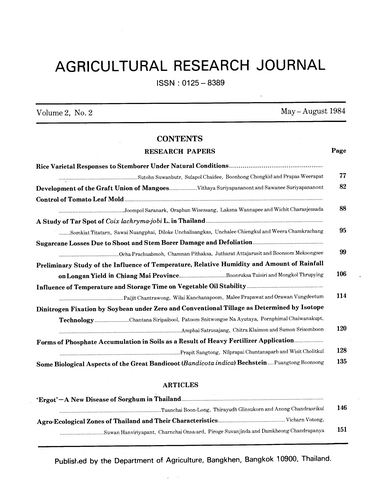Dinitrogen Fixation by Soybean under Zero and Conventional Tillage as Determined by Isotope Technology
Abstract
Ubsing 15N enriched urea fertillzer, a field study was conducted with the primary objective of determining nitrogen fixation of soybean under zero and conventional tillage systems. the experiment was conducted between Februray and April in 1983 on rice paddy soils at the San Pa Tong Rice Research Station in Chhang Mai province, North Thailand. Two nodulation Thai soybean varieties, SJ 1 and 5, a nodulating variety from southern U.S., Maturity 'F' , and a non-nodulating Thai soybean varieties, SJ 1 and SJ 5, a nodulating variety from southern U.s., as urea, the equivalent of zero, 30 and 150 kg N/ha were compared.
On average between 70 and 75% of plant N was fixed by the soybean plant irrespective of the tillage treatments. Between 5 - 7% of plant N was derived from the 15N labelled fertilizer, with the remainding 20 - 25% being supplied by the soil. However, final grain yield was significantly influenced by the tillage treatment, that from the conventional tillage being on average 18% less than from the zero tillage treatment. The two Thai varieties, SJ 2 and SJ 5 fixed significantly more N than the earlier maturing U.S. variety (Maturity 'F') in both tillage systems. the varieties differed in respect to the effect of fertilizer N on N fixation. For the variety SJ 5 N fixation remained variety decreased by 11 and 27% respectively under the conventional and zero tillage treatments. The U.S. variety on average fixed 10% less N than the two Thai varieties.
It was concluded that N ficxation by soybean grown on paddy soils in North thailand is generally high and little influenced by tillage practices. Soybean varieties with similar maturity dates fixed similar amounts of nitrogen Total N in the soybean plant was estimated at 35.6 kg N/ha, of which 26.3 kg N/ha was derived from the atmosphere.
Downloads
Published
How to Cite
Issue
Section
License
Thai Agricultural Research Journal



